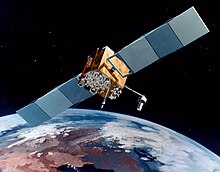GPS satellite blocks



USA-242 · USA-239 · USA-151 · Earth
Note: This animation does not reflect actual orbits which are approximately 350 times denser than these.
A GPS satellite is a satellite navigation used by the NAVSTAR Global Positioning System (GPS). The first satellite in the system, Navstar 1, was launched on 22 February 1978.[1] The GPS satellite constellation is operated by the 2d Space Operations Squadron (2SOPS) of Space Delta 8 (formerly the 50th Space Wing Operations Group) of the United States Space Force.
The GPS satellites circle the Earth at an altitude of about 20,000 km (12,427 miles) and complete two full orbits every day.[2]
Block I satellites
Rockwell International was awarded a contract in 1974 to build the first eight Block I satellites. In 1978, the contract was extended to build an additional three Block I satellites. Beginning with Navstar 1 in 1978, ten "Block I" GPS satellites were successfully launched. One satellite, "Navstar 7", was lost due to an unsuccessful launch on 18 December 1981.[3]
The Block I satellites were launched from Vandenberg Air Force Base using Atlas rockets that were converted intercontinental ballistic missiles. The satellites were built by Rockwell International at the same plant in Seal Beach, California where the S-II second stages of the Saturn V rockets were built.[4]
The Block I series consisted of the concept validation satellites and reflected various stages of system development. Lessons learned from the 10 satellites in the series were incorporated into the fully operational Block II series.
Dual solar arrays supplied over 400 watts of power, charging Nickel-cadmium batteries for operations in Earth's shadow. S-band communications were used for control and telemetry, while an UHF channel provided cross-links between spacecraft. A hydrazine propulsion system was used for orbital correction. The payload included two L-band navigation signals at 1575.42 MHz (L1) and 1227.60 MHz (L2).
The final Block I launch was conducted on 9 October 1985, but the last Block I satellite was not taken out of service until 18 November 1995, well past its 5-year design life.[5]
Block II satellites
Initial Block 2 series
The Block II satellites were the first full scale operational GPS satellites, designed to provide 14 days of operation without any contact from the control segment. The prime contractor was Rockwell International, which built a SVN 12 qualification vehicle after an amendment to the Block I contract. In 1983, the company was awarded an additional contract to build 28 Block II/IIA satellites.
Block II spacecraft were three-axis stabilized, with ground pointing using reaction wheels. Two solar arrays supplied 710 watts of power, while S-band communications were used for control and telemetry. A UHF channel was used for cross-links between spacecraft. A hydrazine propulsion system was used for orbital correction. The payload included two L-band GPS signals at 1575.42 MHz (L1) and 1227.60 MHz (L2). Each spacecraft carried two rubidium and two cesium clocks, as well as nuclear detonation detection sensors, leading to a mass of 1,660 kg (3,660 lb).[6]
The first of the nine satellites in the initial Block II series was launched on 14 February 1989; the last was launched on 1 October 1990.[7] The final satellite of the series to be taken out of service was decommissioned on 15 March 2007, well past its 7.5 year design life.
Block IIA series
The Block IIA satellites were slightly improved versions of the Block II series, designed to provide 180 days of operation without contact from the control segment. However, the mass increased to 1,816 kg (4,004 lb).[8]
Nineteen satellites in the Block IIA series were launched, the first on 26 November 1990 and the last on 6 November 1997. The last satellite of the Block IIA (SVN-34), broadcast on the PRN 18 signal.[9] It was removed from service on 9 October 2019.[10]
Two of the satellites in this series, numbers 35 and 36, are equipped with laser retro-reflectors, allowing them to be tracked independently of their radio signals, providing unambiguous separation of clock and ephemeris errors.[11]
Block IIR series

The Block IIR series are "replenishment" (replacement) satellites developed by Lockheed Martin. Each satellite weighs 2,030 kg (4,480 lb) at launch and 1,080 kg (2,380 lb) once on orbit.[12] The first attempted launch of a Block IIR satellite failed on 17 January 1997 when the Delta II rocket exploded 12 seconds into flight. The first successful launch was on 23 July 1997. Twelve satellites in the series were successfully launched. At least ten satellites in this block carried an experimental S-band payload for search and rescue, known as Distress Alerting Satellite System.[13][14]
Block IIR-M series

The Block IIR-M satellites include a new military signal and a more robust civil signal, known as L2C.[15] There are eight satellites in the Block IIR-M series, which were built by Lockheed Martin.[16] The first Block IIR-M satellite was launched on 26 September 2005. The final launch of a IIR-M was on 17 August 2009.[17]
Block IIF series

The Block IIF series are "follow-on" satellites developed by Boeing. The satellite has a mass of 1,630 kg (3,590 lb) and a design life of 12 years. The first Block IIF space vehicle was launched in May 2010 on a Delta IV rocket.[18] The twelfth and final IIF launch was on 5 February 2016.[19]
Block III satellites
Block IIIA series

GPS Block IIIA is the first series of third-generation GPS satellites, incorporating new signals and broadcasting at higher power levels. In September 2016, the Air Force awarded Lockheed Martin a contract option for two more Block IIIA satellites, setting the total number of GPS IIIA satellites to ten.[20] On 23 December 2018, the first GPS III satellite was launched aboard a SpaceX Falcon 9 Full Thrust. On 22 August 2019, the second GPS III satellite was launched aboard a Delta IV.[21] The third GPS III satellite was launched on 30 June 2020, aboard a SpaceX Falcon 9 launch vehicle.[22] The fourth GPS III satellite launched on 5 November 2020, also aboard a Falcon 9.[23]
Block IIIF series
The Block IIIF series is the second set of GPS Block III satellites, which will consist of up to 22 space vehicles.[24] Block IIIF launches are expected to begin no earlier than 2026 and continue through 2034.[25]
See also
References
- ^ "Navstar 1". gsfc.nasa.gov. NASA. 27 April 2016. Retrieved 25 July 2016.
 This article incorporates text from this source, which is in the public domain.
This article incorporates text from this source, which is in the public domain.
- ^ "The Global Positioning System". harvard.edu.
- ^ "BLOCK I SATELLITE INFORMATION". USNO.
 This article incorporates text from this source, which is in the public domain. [permanent dead link]
This article incorporates text from this source, which is in the public domain. [permanent dead link]
- ^ "Site: Boeing North American, Inc". WTEC.
- ^ "GPS (Navstar)". skyrocket.de.
- ^ "Navstar-2". skyrocket.de.
- ^ "BLOCK II SATELLITE INFORMATION". USNO.
 This article incorporates text from this source, which is in the public domain. [permanent dead link]
This article incorporates text from this source, which is in the public domain. [permanent dead link]
- ^ "Navstar-2A". skyrocket.de.
- ^ "GPS CONSTELLATION STATUS". U.S. Coast Guard Navigation Center. Retrieved 28 October 2018.
 This article incorporates text from this source, which is in the public domain.
This article incorporates text from this source, which is in the public domain.
- ^ "Notice Advisory to GPS Users". navcen.uscg.gov. Retrieved 28 October 2019.
 This article incorporates text from this source, which is in the public domain.
This article incorporates text from this source, which is in the public domain.
- ^ "CDDIS Bulletin - June 1994, Volume 9 No. 5". NASA. Archived from the original on 20 March 2009.
 This article incorporates text from this source, which is in the public domain.
This article incorporates text from this source, which is in the public domain.
- ^ "Global Positioning management System IIR". Lockheed Martin Space Systems Company.
- ^ GPS World (January 2011): The Distress Alerting Satellite System (DASS)
- ^ "NASA". nasa.gov. Retrieved 17 August 2019.
 This article incorporates text from this source, which is in the public domain.
This article incorporates text from this source, which is in the public domain.
- ^ "GLOBALPOSITIONING SYSTEM". USAF. Archived from the original on 16 November 2007.
 This article incorporates text from this source, which is in the public domain.
This article incorporates text from this source, which is in the public domain.
- ^ "Latest GPS IIR-M Sat Goes "Gold" For Lockheed Martin". SatNews. Archived from the original on 23 January 2008.
- ^ "ULA Delta II Completes 20 Year Era With Successful Air Force GPS IIR-21 Launch" Archived 2009-10-01 at the Wayback Machine
- ^ "Boeing Satellite Launch Schedule". Boeing. 15 January 2008.[permanent dead link]
- ^ "Air Force successfully launches GPS IIF-12 satellite". GPS World. 8 February 2016.
- ^ "SMC exercises contract options to procure two additional GPS III satellites". af.mil. 22 September 2016.
 This article incorporates text from this source, which is in the public domain.
This article incorporates text from this source, which is in the public domain.
- ^ "The last single-stick Delta rocket launched Thursday, and it put on a show". Ars Technica. 22 August 2019.
- ^ "Emerged from Its Cocoon, the Third GPS III Now Flies Skyward". insideggns. Inside GGNS. 30 June 2020.
- ^ https://twitter.com/SpaceX/status/1324515570218278912
- ^ Divis, Dee Ann (22 November 2017). "Next Tranche of GPS Satellites to be called GPS IIIF". Inside GNSS. Gibbons Media & Research LLC. Archived from the original on 2 December 2017. Retrieved 1 December 2017.
- ^ Gleckel, Gerry (15 November 2017). "GPS Status and Modernization Program" (PDF). gps.gov. U.S. Air Force. Retrieved 1 December 2017.
 This article incorporates text from this source, which is in the public domain.
This article incorporates text from this source, which is in the public domain.
